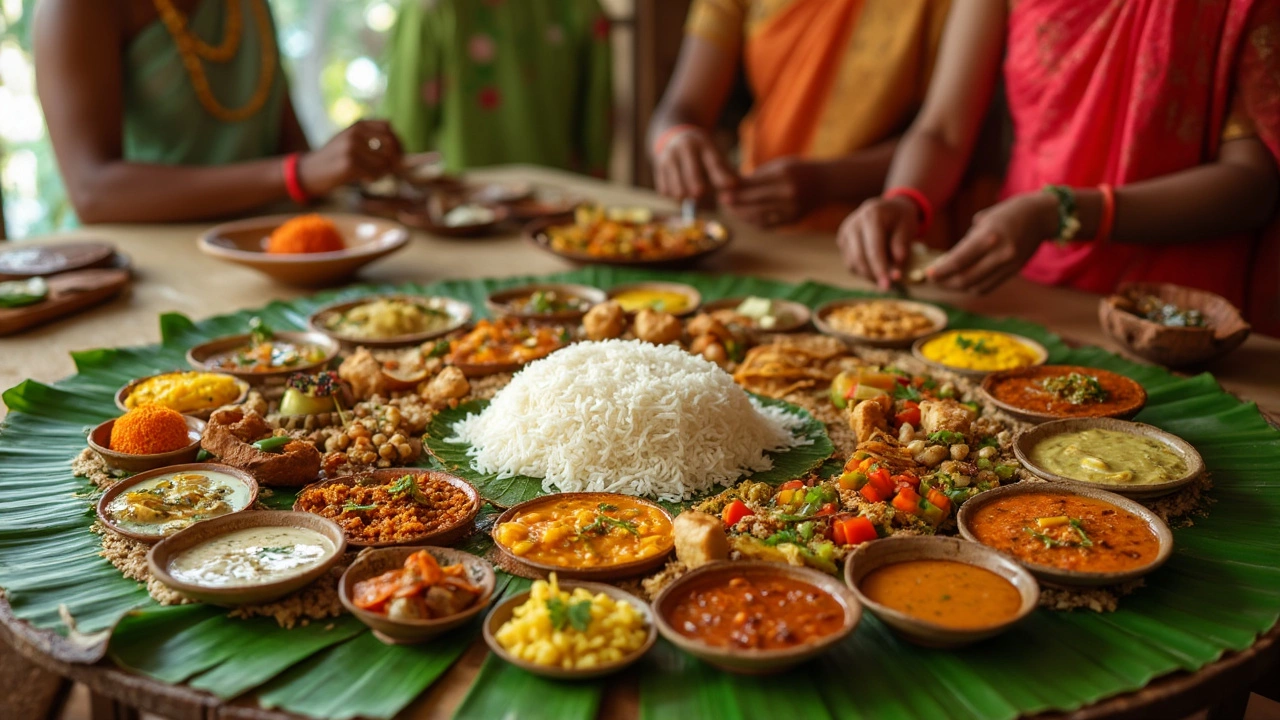SEARCH
Sadya – Your Complete Guide to Kerala’s Traditional Feast
If you’ve ever heard of a meal served on a banana leaf, you’re probably thinking of Sadya. It’s Kerala’s signature vegetarian banquet, usually enjoyed during festivals, weddings, and special occasions. The best part? Every dish is cooked without meat, yet the flavors are bold enough to satisfy anyone.
What’s on the Sadya Plate?
A Sadya plate isn’t just a pile of food – it’s a carefully arranged lineup of about 20 items, each with its own role. You’ll start with a small mound of rice at the center. Around it sit dishes like parippu (lentil dal), sambar (spicy tamarind stew), avial (mixed vegetables in coconut), and thoran (dry-fried veggies with coconut). Sweetness comes from payasam (a creamy dessert made with milk, rice or vermicelli). There’s also pachadi (yogurt with fruit or cucumber) and puli inji (pickled ginger with tamarind) for a tangy kick.Every item is placed in a specific spot on the leaf. The rice sits in the middle, the sweet dishes at one corner, and the tangy pickles opposite. This layout isn’t random – it helps balance flavors as you move from bite to bite.
Where to Experience a Real Sadya
Visiting Kerala and missing Sadya would be a travel faux pas. You can find authentic Sadya at temples during Mahabali Pooja or at restaurants that specialize in Kerala cuisine. Look for places that serve the meal on a banana leaf – that’s a good sign they’re serious about tradition.
If you’re on a budget, street‑food stalls in Kochi or Thiruvananthapuram often serve a simpler version that still includes the essential dishes. For a more upscale experience, try a heritage hotel in Munnar or a beach resort in Varkala. They usually pair Sadya with a short cultural performance, so you get a taste of both food and art.
Here are a few quick tips to make the most of your Sadya experience:
- Eat with your right hand. In Kerala, the left hand is considered unclean for eating.
- Start with rice. Scoop a little with your fingers, then add a spoonful of each side dish as you go.
- Mix flavors. The magic of Sadya is in how sweet, sour, and spicy bite together. Don’t be shy to combine a bit of pachadi with avial or a spoon of payasam after a salty bite.
- Finish with dessert. Payasam is meant to end the meal on a sweet note, so enjoy it slowly.
Remember, Sadya isn’t just about filling your stomach – it’s a cultural ritual that showcases Kerala’s agricultural bounty and culinary skill. By following the simple etiquette and trying a few dishes, you’ll get a real sense of the region’s hospitality.
Next time you plan a trip to India, put Sadya at the top of your food list. Whether you’re a vegetarian or just curious, the combination of flavors, the communal vibe, and the beautiful banana‑leaf presentation will leave a lasting impression.

Kerala Food: What Makes Sadya the Must-Try Feast
Kerala's Sadya meal steals the spotlight as one of the state's most famous foods, served during major festivals and family gatherings. This vegetarian feast is laid out on a banana leaf and packs in dozens of flavors from tangy pickles to creamy payasam. Each dish has a purpose, and eating them in the right order gives you the real experience. In this article, you'll get a breakdown of how Sadya works, what dishes to expect, and tips for trying it for the first time. If food is part of your Kerala travel plan, you don’t want to miss this feast.
Continue reading